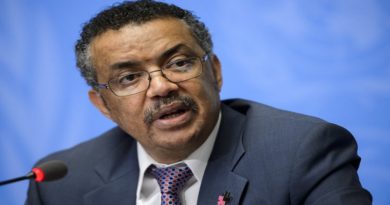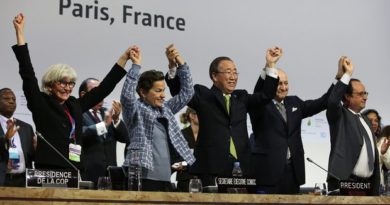Achieving long-term ambition on climate change
Michael Comstock of United Nations Development Programme and Bernd Hackmann of United Nations Climate Change in this treatise, write on the need for countries to have long-term climate ambition.
The 2015 Paris Agreement on climate change establishes the long-term goal of keeping global temperature increases to well below 2 degrees Celsius above pre-industrial levels (and aiming for 1.5 degrees Celsius) to avoid the worst impacts of climate change. Nationally Determined Contributions (NDCs), which articulate national climate change efforts in the context of the Paris Agreement and countries’ development priorities, are not yet sufficient to achieve this long-term global goal. Future NDCs, submitted in 2020 and every five years thereafter, must therefore steadily increase in ambition and move countries closer to sustainable, low-emission development.
The ambitious objective of the Paris Agreement requires that countries think bigger and longer-term than what five-year NDC cycles might imply. To do so, countries may find it useful to step back from individual NDCs and envision where they want to be in terms of sustainable development in the long term – for example, in 2050. Long-standing development priorities – for instance, increasing energy access, increasing citizen mobility, and growing economies – can be assessed through a sustainability lens to articulate a 2050 vision that will contribute to the global climate change solution. Depending on country circumstances, full energy access may be achieved solely from renewables; mobility may be enhanced through fully electric transportation; and economic growth may be advanced through zero-waste, circular-economy models, investments in green technologies, and industrial-efficiency efforts that decarbonize economic growth.
Such a long-term, sustainable-development vision requires a profound shift in the development paradigm. Going forward, countries need to make steady progress toward a whole-of-society approach to transform their economies and mainstream climate in development planning. This means, for example, creating enabling environments for private investment in renewable energy instead of locking in emissions from coal-fired power plants, as well as working with sub-national governments to prioritize clean, public transportation over ever-expanding freeway networks.
Articulating such an ambitious vision will also be an exercise in moving beyond incremental thinking and planning and, in some cases, beyond what is currently realistic. Considering the surfeit of new technologies – and the tumbling costs of these technologies – that the world has witnessed in the last 32 years leads to an appreciation of what is to come in the next 32 years to 2050. While government officials might point to costs or intermittency issues associated with achieving 100 percent renewable energy, renewables are already competitive in many markets, and costs continue to fall. Intermittency challenges may become moot with the advent of inexpensive energy-storage technologies.
The need for a long-term vision is reflected in the Paris Agreement, which invites countries to communicate by 2020 “mid-century, long-term, low greenhouse gas emission development strategies.” These strategies can articulate 2050 aspirations and provide direction to future NDCs, which may be seen as five-year stepping-stones toward long-term visions. Long-term strategies can be living documents, adapted over time to changing circumstances and building on shorter-term development strategies and plans.
Developing these long-term strategies calls for new and innovative approaches. It requires governments to move beyond current ways of doing business and envision an ideal future for their countries and citizens. UNDP and the UNFCCC Secretariat recently incorporated dedicated discussions on long-term strategies and increased ambition at the Regional Dialogue on NDCs for Eastern Europe, the Caucasus, and Central Asia, to invite participants to envision their country objectives for 2050. Now, the Global Meeting on Long-term, Low Greenhouse Gas Emissions Development Strategies, which is taking place 10-11 July 2018 in Bangkok, will carry forward the discussion, inspiring countries to take a step back and move from incremental to ambitious, long-term planning.
Several governments have already responded to the invitation of the Paris Agreement and communicated their long-term strategies to the UNFCCC Secretariat. Mexico, for example, sets out a long-term development vision and roadmap to incorporate climate change into its development plans. The country aims to ensure access to clean energy, good health, and a safe environment for its citizens, while at the same time reducing its national greenhouse gas emissions by 50 percent from 2000 levels by 2050. Mexico’s strategy provides the vision, principles, goals, and lines of action to build a climate-resilient society and achieve low-emissions development in line with national priorities.
Note: This op-ed was written on the occasion of the “Global Meeting on Long-term, Low Greenhouse Gas Emissions Development Strategies: Acting Now for a Sustainable Tomorrow,” 10 and 11 July 2018. The meeting is organized by UNDP, the 2050 Pathways Platform, the LEDS Global Partnership, the NDC Partnership, and World Resources Institute, in cooperation with the UNFCCC Secretariat, with the generous funding from the European Commission, the International Climate Initiative (IKI) of the German Federal Ministry for the Environment, Nature Conservation and Nuclear Safety (BMU), the German Federal Ministry for Economic Cooperation and Development (BMZ), the UK Department for Business, Energy, and Industrial Strategy (UK BEIS), Spain and US State Department.




